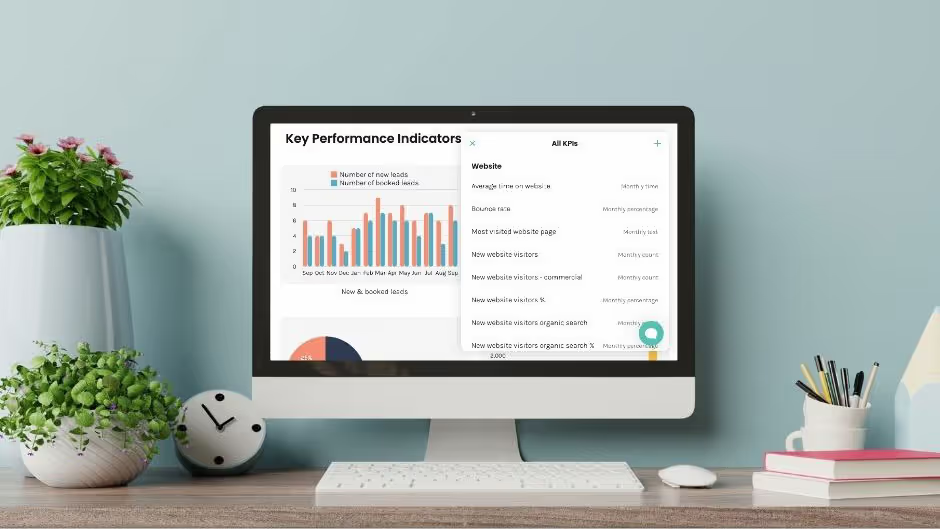Running a small business can feel like riding a rollercoaster… 24/7! One week, you’re up and excited about new leads or customers, while the next, you’re screaming into the void of your email inbox, wondering if anyone is out there. That’s why setting smart goals isn’t just a nice-to-have—it’s a must.
But here’s the thing: smart goals don’t come from vibes alone. They come from data. And not just any data, but your data. Your content performance, your lead generation numbers, your sales trends. Your actual business activity, not someone else’s formula.
Enji’s KPI Dashboard gives you the insight you need to stop guessing and start growing. Whether you’re flying solo or juggling a lean team, this dashboard helps you track what matters, measure what’s working, and adjust your plan with confidence.
In this post, we’ll show you how to use your KPI dashboard to set sharper, more strategic goals. Spoiler alert: it’s not just about watching the numbers go up (though that part is fun too).
We’re going to cover:
- Why your KPI dashboard is more than a pretty way to celebrate your numbers
- What you likely started with to set your goals
- How KPIs and tracking your results helps you set better goals
- Examples of smarter goals you can set
- Tracking the KPIs that matter
- How Enji ties it all together
Why Your KPI Dashboard is More Than a Pretty Way to Celebrate Your Numbers
There’s a time and place for vibes-based decision-making (we’re not above flipping a coin now and then), but when it comes to building sustainable growth? You need more than good instincts. You need data. Reliable, accessible, easy-to-read data that helps you understand what’s working, what’s not, and where to focus next.
That’s where your KPI dashboard comes in.
Key Performance Indicators (KPIs) are the essential signals that show whether your marketing is helping you hit your business goals or not. When you check your dashboard regularly (even just once a month on KPI Day is good!), you can stop spinning your wheels with tactics that aren’t working and double down on what is moving the needle.
And listen, we get it. Being an entrepreneur is emotional. One great sales week and you’re flying high. One quiet post or email, and you’re questioning everything. But when you’ve got numbers to guide you? You can stay grounded, stay strategic, and keep momentum going.
What You Likely Started With to Set Your Goals
We’re going to take a wild guess and say you probably set your first few goals based on one of two things: your gut or vibes (or a mix of both). Maybe you set a revenue target that felt achievable. Maybe you wanted to post to Instagram five times a week because someone on a podcast said that was the magic number. Or maybe you did look at your past year and pull a few actual numbers. If so, we’re proud of you!
Here’s the thing: starting with gut instincts or general advice is fine. It’s what most small business owners do. But if you want to:
- Actually reach your goals instead of just crossing your fingers
- Understand why you hit (or missed) them
- Set better, more realistic goals next time (both realistic and stretch goals!)
...then it’s time to start using real data. Your KPI dashboard gives you a foundation to measure progress, tweak your approach, and get clearer about what’s worth your time and effort.
How KPIs and Tracking Your Results Will Help You Set Better Goals
Let’s say you ran a summer promo (read: a marketing campaign) last year and got a handful of sales. Great! But which part worked? The email? The Instagram posts? The last-minute live video?
Without KPIs, you’re looking at vibe soup. Because even though you did a bunch of marketing, you don’t have anything that shows you “this worked” or “this didn’t work”. So how are you supposed to know what to do again, tweak, or ditch the next time? When you track KPIs, you’re able to break out the moving parts and see what contributed to your results.
You’ll see where leads came from, which channels got the most traction, and what tactics converted best. And from there? You can:
- Notice patterns and plan accordingly (e.g. Instagram performs better when paired with email, etc.)
- Get ahead of dips by spotting early signs of drop-off
- Set goals that reflect your actual performance (not a random number you pulled from the ether)
Numbers take the pressure off and help you set the smartest goals (and sometimes the best expectations). You can see what’s realistic for your business and bandwidth, and feel confident about what you’re aiming for.
Smarter Goals You Can Set
So now that you’re looking at real data, what can you do with it? Here are a few examples of data-backed goals that go beyond "grow the business" (we love you, but you need to be more specific!):
- Increase return customer rate by 15% next quarter using targeted upsells
- Boost email open rates by 10% by experimenting with new subject lines
- Grow your list by 100 new subscribers through a lead magnet campaign
- Improve Instagram engagement by 25% by testing Reels vs. static posts
- Decrease cost per lead by 20% with retargeting ads
Specific goals help you focus. You’re not just "doing marketing" anymore—you’re working toward measurable results.
You can document these goals directly in your KPIs or in your strategy.
Tracking the KPIs That Matter
There are a lot of marketing metrics out there. Some are useful. Some are… distractions. The KPIs you track should align with your goals and reflect each stage of your customer journey. That typically looks something like:
1. Discovery KPIs (How people are finding you)
- Website traffic
- Social media impressions
- Ad reach
- Search rankings
2. Engagement KPIs (How people are showing interest)
- Follower growth
- Email list signups
- Page views per visit
- Content shares/comments
3. Conversion KPIs (How people are buying)
- Number of sales/inquiries
- Conversion rates
- Cost per lead or acquisition (CAC)
- Abandoned carts
4. Retention KPIs (How people are staying)
- Customer Lifetime Value (LTV)
- Repeat purchases
- Referral rates
- Churn or unsubscribe rates
You don’t need to track everything all at once. But you do need to look at the metrics that match your goals. Trying to boost engagement? Don’t just look at traffic. Want to improve retention? Start with LTV (lifetime value) and repeat buyer stats.
How Enji Ties It All Together
We built Enji with small business owners in mind—the solopreneurs, the side-hustlers, the scrappy marketers trying to do it all. That’s why your KPI dashboard is front and center in the platform.
Here’s what you get:
- KPI tracking for your top metrics, updated monthly (automatically!)
- A monthly reminder (on KPI Day) to check in, reflect, and recalibrate
- The ability to see campaign performance clearly—whether you used an Enji-recommended plan or built your own
- A visual calendar to show your marketing activity alongside your results, so you can spot gaps or patterns fast
- Built-in action steps to help you course-correct if something dips (so you’re not just staring at a dashboard wondering what to do)
Data is only helpful if you actually use it. Enji makes that part easy with built-in tools and integrations that you can set up easily!
When you’re not sure where to go next, your numbers are there to point the way. They won’t make the decision for you, but they’ll help you feel a whole lot more confident about the decision you do make.
And because your data, campaigns, calendar, and content ideas all live in one place? You can go from insight to action in less than ten minutes—no tab-switching required.
With Enji, it looks like this: Data ➔ Plan ➔ Action. Ready to make your data work for you? Login to Enji now and head to your performance tab





